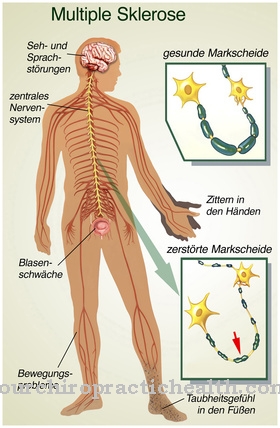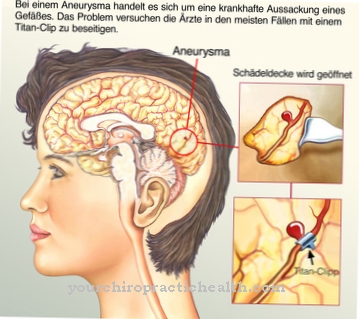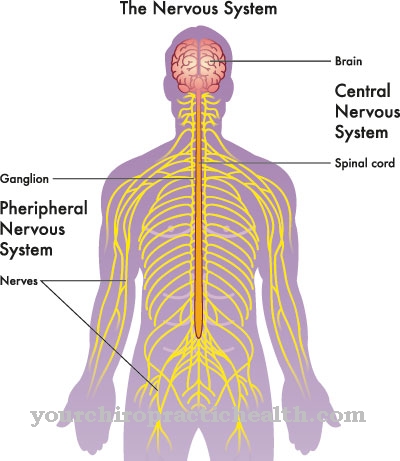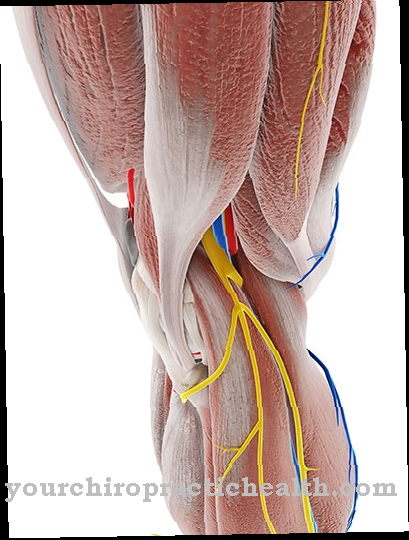At the Paget von Schroetter syndrome it is a thrombosis that occurs in the deep arm vein, clavicle vein, or axillary vein. The disease mainly affects young adult men.
What is Paget von Schroetter Syndrome?

© Olga - stock.adobe.com
In medicine it works Paget von Schroetter syndrome also the term arm and shoulder girdle vein thrombosis. The disease was named after the British doctor James Paget (1814-1899) and the Austrian doctor Leopold Schroetter Ritter von Kristelli (1837-1908). Other names of the syndrome are axillary vein obstruction and deep arm vein thrombosis.
In Paget von Schroetter syndrome there is an acute thrombosis on the Subclavian vein (Collarbone vein) or the Axillary vein (Axillary vein). In the case of chronic outflow disorders of the veins, doctors speak of a thoracic inlet syndrome (TIS). Paget von Schroetter syndrome is one of the rare diseases. It shows up primarily in young adults, who are predominantly men.
Sometimes children also get the syndrome. In most cases, Paget von Schroetter syndrome occurs on the right side of the body. Around two percent of all thromboses are found in the arm and shoulder girdle region.
causes
The causes of Paget von Schroetter syndrome are different. The thoracic outlet syndrome, among other things, is a possible trigger. There is compression of the vascular nerve cord in the transition region between arm and chest. Thoracic outlet syndrome is usually caused by functional phenomena such as a narrowing between the first rib and collarbone or musculoskeletal anomalies.
It is not uncommon for Paget von Schroetter syndrome to appear even after strenuous work such as overhead work with the arm. This can include painting walls, carrying a backpack for long periods of time, or chopping wood. Sports activities such as wrestling, tennis, basketball or handball can also result in Paget von Schroetter syndrome.
Another possible cause is wearing a central venous catheter. The disease usually occurs after a long period of lying in bed and after extensive infusions of hyperosmolar solutions. In some patients, despite thorough examinations, the doctor cannot determine any specific cause of Paget-von-Schroetter syndrome. The thrombosis shows up spontaneously.
Symptoms, ailments & signs
A typical symptom of Paget von Schroetter syndrome is pain in the affected limb. Swelling is also possible. In some cases, the arm turns reddish or bluish in color. In addition, the surface veins are visible through blotchy skin. This is an indication that bypass cycles are developing. Other conceivable complaints are feelings of tension and pressure in the armpit.
A pulmonary embolism caused by the detachment of a thrombus (blood clot) is considered a dangerous complication. The embolism often manifests itself in pain in the chest and shortness of breath.
Diagnosis & course of disease
A doctor should be consulted if Paget von Schroetter syndrome is suspected. This first deals with the patient's medical history (anamnesis) and their complaints. He also checks to see if nerves and arteries are involved in the syndrome. For example, there may be a reduced arterial supply, a one-sided loss of strength or paresthesia.
The doctor will perform various clinical tests. These include the Wright hyperabduction test, as well as raising the arm or turning the head in a specific direction, also known as the Adson maneuver. In this way, the doctor will determine a vanishing arterial pulse, which is considered an indication of thoracic outlet syndrome.
As part of the anamnesis, the doctor checks whether the patient engages in certain physical or sporting activities that can cause Paget von Schroetter syndrome. Duplex sonography is usually used to confirm the diagnosis. In some cases, venography may also be required. If the genesis is due to compression, it is important to ensure suitable imaging.
It is also important to rule out malignant neoplasms or extensive humerus hematomas as a trigger for compression. This can sometimes be caused by lymph node metastases in the armpit. In most cases, Paget-von-Schroetter syndrome takes a favorable course. Post-thrombotic syndrome rarely occurs on the arm.
Complications
In most cases, those affected by this syndrome suffer from very severe pain and also from sensory disorders in the affected joints and regions. Since this pain can occur not only during exertion, but in many cases also at night, it also leads to sleep problems and furthermore to depression and other psychological upsets.
The regions are clearly swollen and the skin is reddish in color. It can also lead to a feeling of tension or pressure in the armpits of the person concerned. Paget von Schroetter syndrome also leads to pulmonary embolism, which can be fatal for the patient. Those affected suffer from shortness of breath and relatively severe pain that occurs in the chest.
Due to the Paget-von-Schroetter syndrome, the patient's quality of life is significantly reduced and restricted. If the disease occurs at a young age, it can lead to various disorders of development and growth in the patient. Treatment of Paget von Schroetter syndrome is not associated with complications. The symptoms can be alleviated with the help of medication. However, many of those affected are still dependent on a pacemaker to increase life expectancy.
When should you go to the doctor?
Swelling or discoloration of the skin's appearance indicate irregularities that should be examined and clarified by a doctor. If the skin turns red or bluish, treatment is required and a doctor should be consulted. Most of the time, the symptoms occur in the area of the arm. A doctor should be consulted if there are feelings of tension in the upper body or disorders of the blood circulation. If the symptoms spread to under the armpits, you should see a doctor as soon as possible.
Feelings of pressure, sensory disturbances and hypersensitivity to touch are signs of an existing health impairment and should be examined. Chest pain and shortness of breath are among the acute symptoms of Paget-von-Schroetter syndrome that require immediate action. In severe cases, the emergency services should be alerted. At the same time, ventilation of the person concerned must be ensured by taking first aid measures. Since the risk group of Paget-von-Schroetter syndrome mainly includes young adult men, a visit to a doctor is necessary, especially in these groups of people, if symptoms arise.
In the event of sudden restrictions in breathing, a decrease in performance or internal weakness, the person concerned needs immediate help. Disorders in the development process of a child or adolescent as well as an underdevelopment of the growth should be discussed with a doctor. If there are additional psychological problems, medical help should be sought.
Treatment & Therapy
Treatment of Paget-von-Schroetter syndrome is possible in both a conservative and an operative way. As part of conservative therapy, the affected arm is raised. In addition, the patient is given injections of heparin. If the thrombosis can be resolved, coumarin derivatives are given for a period of six months.
If the thrombosis is severe, fibrinolysis with plasminogen activators takes place in most cases. If this treatment procedure cannot be carried out, surgical therapy is required. In this case, for example, exotic areas of the first rib or a cervical rib are removed.
The most important therapy goals in Paget-von-Schroetter syndrome are to avoid post-thrombotic syndrome and pulmonary embolism. Conservative treatment is mostly only used in exceptional cases. This therapeutic method is not able to counteract a post-thrombotic syndrome. Fibrinolysis achieves similarly good effects as operative thromebectomy.
The success rate is around 80 percent. A surgical procedure is used when there are contraindications to lysis or Phlegmasia coerulea dolens. However, there are also contraindications to surgery. These include thromboses due to intravenous permanent implants such as pacemakers, thromboses due to tumor compression and a weakened general state of health of the person concerned.
Outlook & forecast
Overall, Paget von Schroetter syndrome has a relatively good prognosis. With appropriate treatment, the vessel opens again within a few weeks. At the same time, the tendency of the arm to swell and the sometimes very severe pain, which can have a very negative effect on the patient's well-being, especially in the first days of the disease, are usually reduced.
The risk of pulmonary embolism is relatively low compared to leg and pelvic vein thrombosis. The prognosis is always based on the individual symptoms and the general condition of the patient. The attending physician also takes into account the willingness of the patient to have surgical measures carried out. The procedures include the removal of cervical ribs and carry a certain risk of complications. Nevertheless, the prognosis is relatively good.
Life expectancy is not reduced as long as the thrombosis is treatable. Thromboses like Paget-von-Schroetter syndrome occur again and again in high-risk patients. Close medical supervision is therefore necessary. The doctor must make the long-term prognosis of the number and severity of thrombosis the patient will experience in life.
prevention
There is no known prevention against Paget von Schroetter syndrome. In some cases, however, certain measures, such as avoiding excessive overhead work or special sports activities, can be helpful.
Aftercare
With Paget-von-Schroetter syndrome, in most cases, those affected have very few measures and options for direct follow-up care. Those affected should ideally consult a doctor at an early stage so that there are no other complications or further worsening of the symptoms. The earlier a doctor is contacted, the better the further course is usually, so that those affected should ideally see a doctor at the first signs and symptoms of the disease.
As a rule, Paget von Schroetter syndrome cannot heal itself. Even after the initial treatment, patients are often dependent on taking various medications. Those affected should pay attention to the correct dosage with regular intake in order to relieve the symptoms permanently and, above all, properly.
Regular checks of the internal organs are also very important in order to monitor the condition and detect damage at an early stage. Furthermore, those affected with this disease should ensure a healthy lifestyle with a healthy diet to alleviate the symptoms. In some cases, the syndrome reduces the life expectancy of those affected, but no general predictions can be made about it.
You can do that yourself
Patients with Paget-von-Schroetter syndrome should generally avoid work in which the arm has to be carried over the head for a long time.
Painting the walls, cleaning windows, or chopping wood are some of the activities that should be avoided. The sporting activities must also be adapted to the possibilities and needs of the body. Those affected should avoid sports such as handball, basketball, swimming or tennis. During these activities, the arm is often brought up over the shoulder and can cause pain or swelling. In addition, carrying a rucksack or bag over the shoulder is not beneficial for the patient's health and should therefore be avoided.
The activities mentioned can aggravate existing symptoms or lead to a recurrence of health problems. Everyday life has to be restructured so that when performing daily tasks, care is always taken to ensure that the arm and shoulder are only exposed to low stress. At the first irregularities or if you feel unwell, you should take a break. In addition, the posture must be changed so that no complaints occur. If the usual performance decreases or if there is a tingling sensation in the shoulder or arm, the activities must be stopped immediately.



























